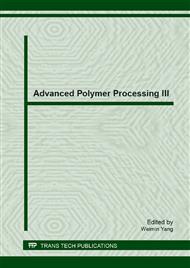[1]
D. Exerowa and P. M. Kruglyakov, "Foam and Foam Films: Theory, Experiments, Application", Elsevier (1998).
DOI: 10.1016/s1383-7303(13)60004-6
Google Scholar
[2]
W. R. Rossen, "Foams in enhanced oil recovery". In: R. K. Prud'homme and S. Khan (Editors), Foams: Theory, Measurements and Applications. Marcel Dekker (1996).
DOI: 10.1201/9780203755709-11
Google Scholar
[3]
L. W. Holm, "The Mechanism of Gas and Liquid Flow through Porous Media in the Presence of Foam", SPE J., Vol.8, No.4 (1968), p.359.
Google Scholar
[4]
J. Ali, R. W. Burley and C. W. Nutt, "Foam Enhanced Oil-Recovery from Sand Packs", Chemical Engineering Research and Design, Vol.63, No.3(1985), p.101.
Google Scholar
[5]
W. Lake, "Enhanced Oil Recovery", Prentice Hall (1989).
Google Scholar
[6]
T. W. Patzek, "Field Application of Foam for Mobility Improvement and Profile Control", SPE Reservoir Engineering, Vol.11, No.2 (1996), p.79.
DOI: 10.2118/29612-pa
Google Scholar
[7]
A. T. Turta and A. K. Signhal, "Field Foam Applications in Enhanced Oil Recovery Projects: Screening and Design Aspect", SPE 48895 in SPE International Oil and Gas Conference and Exhibition in China (1998).
DOI: 10.2118/48895-ms
Google Scholar
[8]
D. X. Du, A. Naderi Beni, R. Farajzadeh and P. L. J. Zitha, "Effect of Water Solubility on Carbon Dioxide Foam Flow in Porous Media: an X-Ray Computed Tomography Study", Industrial & Engineering Chemistry Research, Vol.47, No.16 (2008), p.6298.
DOI: 10.1021/ie701688j
Google Scholar
[9]
F. P. Bretherton: "The motion of Long bubbles in Tubes", J. Fluid Mech.,Vol.10, No.2 (1961) p.166.
Google Scholar
[10]
G.J. Hirasaki and J.B. Lawson: "Mechanisms of foam flow in porous media: Apparent viscosity in smooth capillaries", SPE J., Vol.25, No.2 (1985) 176-190.
DOI: 10.2118/12129-pa
Google Scholar
[11]
Q.P. Nguyen, P. K. Currie and P. L. J. Zitha: "Motion of foam films in diverging-converging channels", Journal of Colloid and Interface Science, Vol.271, No.2 (2004), p.473.
DOI: 10.1016/j.jcis.2003.12.010
Google Scholar
[12]
Q. Xu and W. R. Rossen, "Effective Viscosity of Foam in Periodically Constricted Tubes", Colloids and Surfaces A, Vol. 216, No.1-3 (2003), p.175.
DOI: 10.1016/s0927-7757(02)00547-2
Google Scholar
[13]
K. Brakke. The Surface Evolver. Exp. Math. 1:141–165 (1992).
Google Scholar
[14]
S. J. COX . A viscous froth model for dry foams in the SurfaceEvolver, Colloids and Surfaces A: Physicochemical and Engineering Aspects,Volume 263, Issues 1–3, 1 August 2005, p.81–89
DOI: 10.1016/j.colsurfa.2004.12.061
Google Scholar
[15]
N. Kern, D. Weaire, A. Martin, S. Hutzler, and S. J. Cox. . Two-dimensional viscous froth model for foam dynamics. PHYSICAL REVIEW E 70,041411 (2004) .
DOI: 10.1103/physreve.70.041411
Google Scholar
[16]
T. Okuzono, K. Kawasaki and T. Nagai.. Rheology of Random Foams. J. Rheol. 37:571–586. (1993).
DOI: 10.1122/1.550383
Google Scholar
[17]
T. Okuzono and K. Kawasaki.. Intermittent flow behavior of random foams: A computer experiment on foam rheology. Phys. Rev. E 51:1246–1253(1995).
DOI: 10.1103/physreve.51.1246
Google Scholar
[18]
S.J. Cox, S. Neethling, W.R. Rossen, W. Schleifenbaum, P. Schmidt-Wellenburg, J. J. Cilliers. A theory of the effective yield stress of foam in porous media: the motion of a soap film traversing a three-dimensional pore. Colloids and Surfaces A: Physicochem. Eng. Aspects 245 (2004) 143–151.
DOI: 10.1016/j.colsurfa.2004.07.004
Google Scholar


